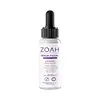What's inside
What's inside
 Key Ingredients
Key Ingredients

 Benefits
Benefits

 Concerns
Concerns

 Ingredients Side-by-side
Ingredients Side-by-side

Water
Skin ConditioningNiacinamide
SmoothingThiamine Hcl
MaskingPyridoxine
Skin ConditioningPanthenol
Skin ConditioningRiboflavin
Cosmetic ColorantBiotin
AntiseborrhoeicCyanocobalamin
Skin ConditioningSaccharomyces Cerevisiae Extract
Skin ConditioningGlycerin
HumectantPolyacrylamide
C13-14 Isoparaffin
EmollientLaureth-7
EmulsifyingDimethicone
EmollientDimethicone Crosspolymer
Emulsion StabilisingPhenoxyethanol
PreservativePEG-40 Hydrogenated Castor Oil
EmulsifyingImidazolidinyl Urea
PreservativeLactic Acid
BufferingHydrolyzed Collagen
EmollientCetyl Alcohol
EmollientTocopheryl Acetate
AntioxidantCentella Asiatica Leaf Extract
Skin ConditioningAloe Ferox Leaf Juice Extract
Skin ConditioningPrunus Amygdalus Dulcis Oil
Skin ConditioningCyclopentasiloxane
EmollientTriethanolamine
BufferingEDTA
Water, Niacinamide, Thiamine Hcl, Pyridoxine, Panthenol, Riboflavin, Biotin, Cyanocobalamin, Saccharomyces Cerevisiae Extract, Glycerin, Polyacrylamide, C13-14 Isoparaffin, Laureth-7, Dimethicone, Dimethicone Crosspolymer, Phenoxyethanol, PEG-40 Hydrogenated Castor Oil, Imidazolidinyl Urea, Lactic Acid, Hydrolyzed Collagen, Cetyl Alcohol, Tocopheryl Acetate, Centella Asiatica Leaf Extract, Aloe Ferox Leaf Juice Extract, Prunus Amygdalus Dulcis Oil, Cyclopentasiloxane, Triethanolamine, EDTA
Water
Skin ConditioningButylene Glycol
HumectantLactobacillus/Portulaca Oleracea Ferment Extract
AntioxidantAlcohol
AntimicrobialSodium Hyaluronate
HumectantGlycerin
HumectantMagnesium Carboxymethyl Beta-Glucan
Skin ConditioningOnopordum Acanthium Flower/Leaf/Stem Extract
Skin ConditioningCassia Alata Leaf Extract
AstringentLeuconostoc/Radish Root Ferment Filtrate
AntimicrobialPhragmites Karka Extract
Skin ConditioningPoria Cocos Extract
Skin ConditioningPlankton Extract
Skin ConditioningXanthan Gum
EmulsifyingEthylhexylglycerin
Skin ConditioningPhenoxyethanol
PreservativeSodium Benzoate
MaskingWater, Butylene Glycol, Lactobacillus/Portulaca Oleracea Ferment Extract, Alcohol, Sodium Hyaluronate, Glycerin, Magnesium Carboxymethyl Beta-Glucan, Onopordum Acanthium Flower/Leaf/Stem Extract, Cassia Alata Leaf Extract, Leuconostoc/Radish Root Ferment Filtrate, Phragmites Karka Extract, Poria Cocos Extract, Plankton Extract, Xanthan Gum, Ethylhexylglycerin, Phenoxyethanol, Sodium Benzoate
Ingredients Explained
These ingredients are found in both products.
Ingredients higher up in an ingredient list are typically present in a larger amount.
Glycerin is already naturally found in your skin. It helps moisturize and protect your skin.
A study from 2016 found glycerin to be more effective as a humectant than AHAs and hyaluronic acid.
As a humectant, it helps the skin stay hydrated by pulling moisture to your skin. The low molecular weight of glycerin allows it to pull moisture into the deeper layers of your skin.
Hydrated skin improves your skin barrier; Your skin barrier helps protect against irritants and bacteria.
Glycerin has also been found to have antimicrobial and antiviral properties. Due to these properties, glycerin is often used in wound and burn treatments.
In cosmetics, glycerin is usually derived from plants such as soybean or palm. However, it can also be sourced from animals, such as tallow or animal fat.
This ingredient is organic, colorless, odorless, and non-toxic.
Glycerin is the name for this ingredient in American English. British English uses Glycerol/Glycerine.
Learn more about GlycerinPhenoxyethanol is a preservative that has germicide, antimicrobial, and aromatic properties. Studies show that phenoxyethanol can prevent microbial growth. By itself, it has a scent that is similar to that of a rose.
It's often used in formulations along with Caprylyl Glycol to preserve the shelf life of products.
Water. It's the most common cosmetic ingredient of all. You'll usually see it at the top of ingredient lists, meaning that it makes up the largest part of the product.
So why is it so popular? Water most often acts as a solvent - this means that it helps dissolve other ingredients into the formulation.
You'll also recognize water as that liquid we all need to stay alive. If you see this, drink a glass of water. Stay hydrated!
Learn more about Water